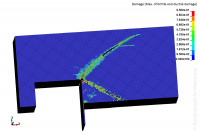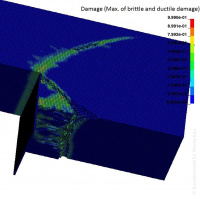Non-linear probabilistic calculations: Difference between revisions
From BAWiki
No edit summary |
The LinkTitles extension automatically added links to existing pages (<a target="_blank" rel="nofollow noreferrer noopener" class="external free" href="https://github.com/bovender/LinkTitles">https://github.com/bovender/LinkTitles</a>). |
||
| Line 1: | Line 1: | ||
[[File:10_Probabilistische_Berech_01.jpg|200px|thumb|right|Picture 1: Crack formation in a niche section made from unreinforced concrete with 3D distribution of compressive strength in the vicinity of the loading]]The BAW’s TbW* Code of Practice enables more detailed investigation methods to be applied in a multi-stage process if the load-bearing capacity of existing solid hydraulic structures cannot be formally verified in a single step using the current regulations. The use of non-linear probabilistic calculations is illustrated below using the example of material properties: The broad spread of compositions and mixtures of the building materials used in solid construction prompts an approach whereby a 5 per cent quantile value is used for material properties. | [[File:10_Probabilistische_Berech_01.jpg|200px|thumb|right|Picture 1: Crack formation in a niche section made from unreinforced concrete with 3D distribution of compressive strength in the vicinity of the loading]]The BAW’s TbW* Code of Practice enables more detailed investigation methods to be applied in a multi-stage process if the load-bearing capacity of existing solid hydraulic structures cannot be formally verified in a single step using the current regulations. The use of non-linear probabilistic calculations is illustrated below using the example of material properties: The broad spread of compositions and mixtures of the [[building]] materials used in solid construction prompts an approach whereby a 5 per cent quantile value is used for material properties. | ||
The first stages in accordance with TbW apply this value according to the relevant material or construction period or set out tests that also result in 5 per cent quantile values. In the third stage in accordance with TbW, FEM simulations are used to map the non-linear material behaviour as realistically as possible, while employing probabilistic methods enables the anticipated range of the building material used to be taken into account. | The first stages in accordance with TbW apply this value according to the relevant material or construction period or set out tests that also result in 5 per cent quantile values. In the third stage in accordance with TbW, FEM simulations are used to map the non-linear material behaviour as realistically as possible, while employing probabilistic methods enables the anticipated range of the [[building]] material used to be taken into account. | ||
[[File:10_Probabilistische_Berech_02.jpg|200px|thumb|right|Picture 2: Crack formation and breakout in a niche section made from unreinforced concrete with 3D distribution of compressive strength in the vicinity of the loading]]To this end, the material properties follow a characteristic curve that is imposed on the FEM model in a spatial distribution. Depending on its characteristics, the 3D variation can furnish decisive insights into the load-bearing capacity of the component in question and thus constitute a design parameter itself. The robustness of different combinations of spatial distributions and typical spread of variations in material properties is investigated in scenarios. The probability of failure and the level of reliability of the load cases under consideration are determined by the component’s behaviour patterns. Fig. 1 and Fig. 2 show examples of the different crack formations and damage that can be sustained in a niche section with the same pattern of load application and characteristic curve but with a different spatial distribution. | [[File:10_Probabilistische_Berech_02.jpg|200px|thumb|right|Picture 2: Crack formation and breakout in a niche section made from unreinforced concrete with 3D distribution of compressive strength in the vicinity of the loading]]To this end, the material properties follow a characteristic curve that is imposed on the FEM [[model]] in a spatial distribution. Depending on its [[characteristics]], the 3D variation can furnish decisive insights into the load-bearing capacity of the component in question and thus constitute a design parameter itself. The robustness of different combinations of spatial distributions and typical spread of variations in material properties is investigated in scenarios. The probability of failure and the level of reliability of the load cases under consideration are determined by the component’s behaviour patterns. Fig. 1 and Fig. 2 show examples of the different crack formations and [[damage]] that can be sustained in a niche section with the same pattern of load application and characteristic curve but with a different spatial distribution. | ||
*TbW: German Federal Waterways Engineering and Research Institute (Ed.) (2016): BAW Code of Practice “Evaluation of the load bearing capacity of existing solid hydraulic structures” (TbW). Karlsruhe: German Federal Waterways Engineering and Research Institute (BAW Codes of Practice, Recommendations and Guidelines). | *TbW: German [[Federal waterways engineering and research institute|Federal Waterways Engineering and Research Institute]] (Ed.) (2016): BAW Code of Practice “Evaluation of the load bearing capacity of existing solid hydraulic structures” (TbW). Karlsruhe: German [[Federal waterways engineering and research institute|Federal Waterways Engineering and Research Institute]] (BAW Codes of Practice, Recommendations and Guidelines). | ||
---- | ---- | ||
Latest revision as of 09:51, 21 October 2022

The BAW’s TbW* Code of Practice enables more detailed investigation methods to be applied in a multi-stage process if the load-bearing capacity of existing solid hydraulic structures cannot be formally verified in a single step using the current regulations. The use of non-linear probabilistic calculations is illustrated below using the example of material properties: The broad spread of compositions and mixtures of the building materials used in solid construction prompts an approach whereby a 5 per cent quantile value is used for material properties.
The first stages in accordance with TbW apply this value according to the relevant material or construction period or set out tests that also result in 5 per cent quantile values. In the third stage in accordance with TbW, FEM simulations are used to map the non-linear material behaviour as realistically as possible, while employing probabilistic methods enables the anticipated range of the building material used to be taken into account.

To this end, the material properties follow a characteristic curve that is imposed on the FEM model in a spatial distribution. Depending on its characteristics, the 3D variation can furnish decisive insights into the load-bearing capacity of the component in question and thus constitute a design parameter itself. The robustness of different combinations of spatial distributions and typical spread of variations in material properties is investigated in scenarios. The probability of failure and the level of reliability of the load cases under consideration are determined by the component’s behaviour patterns. Fig. 1 and Fig. 2 show examples of the different crack formations and damage that can be sustained in a niche section with the same pattern of load application and characteristic curve but with a different spatial distribution.
- TbW: German Federal Waterways Engineering and Research Institute (Ed.) (2016): BAW Code of Practice “Evaluation of the load bearing capacity of existing solid hydraulic structures” (TbW). Karlsruhe: German Federal Waterways Engineering and Research Institute (BAW Codes of Practice, Recommendations and Guidelines).
back to: Structural Engineering Methods
